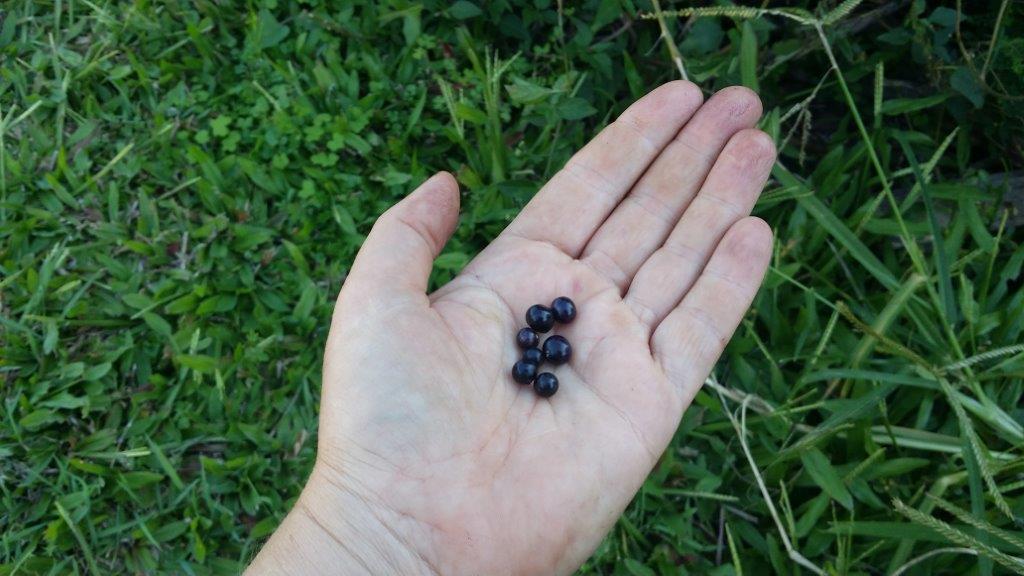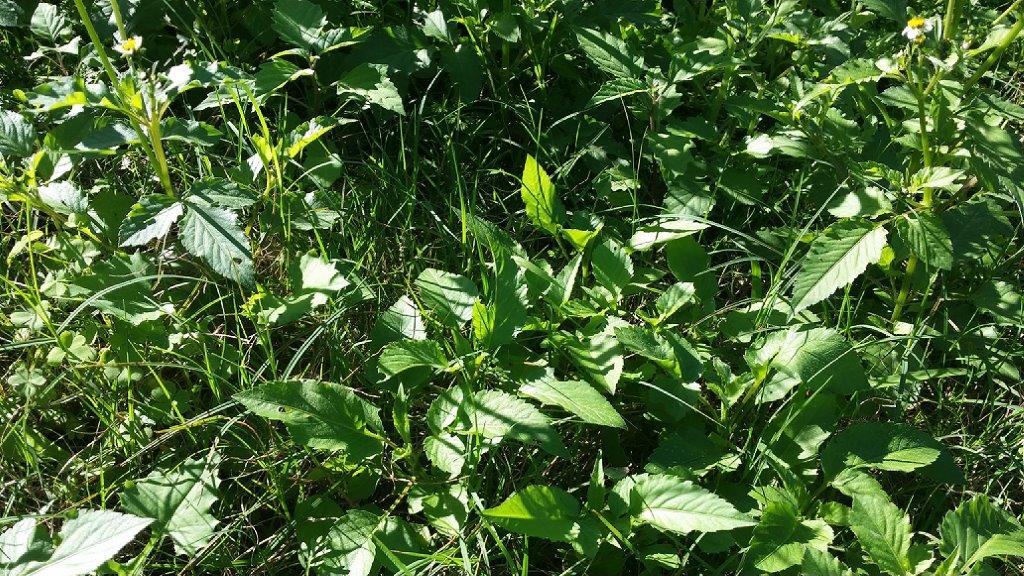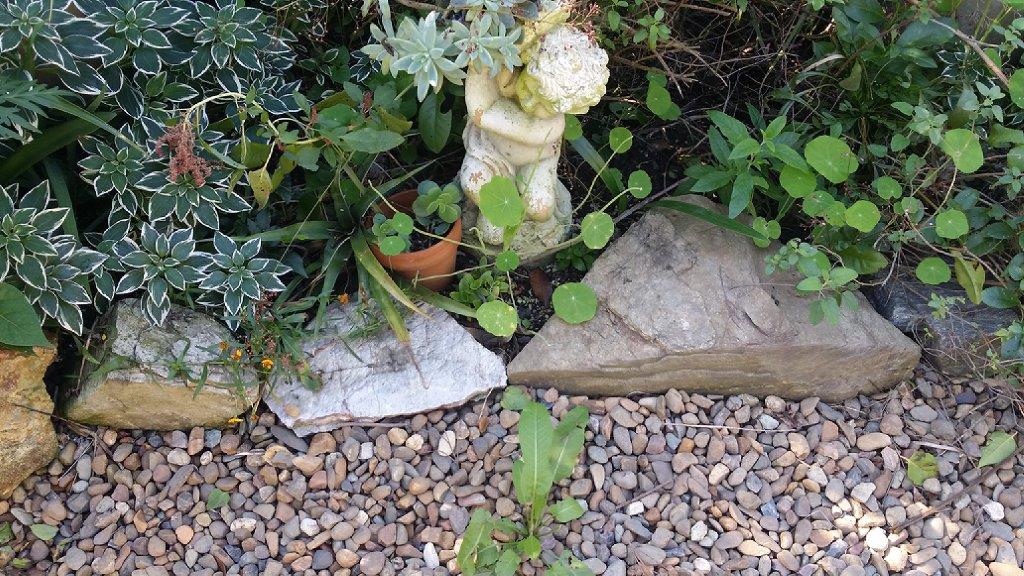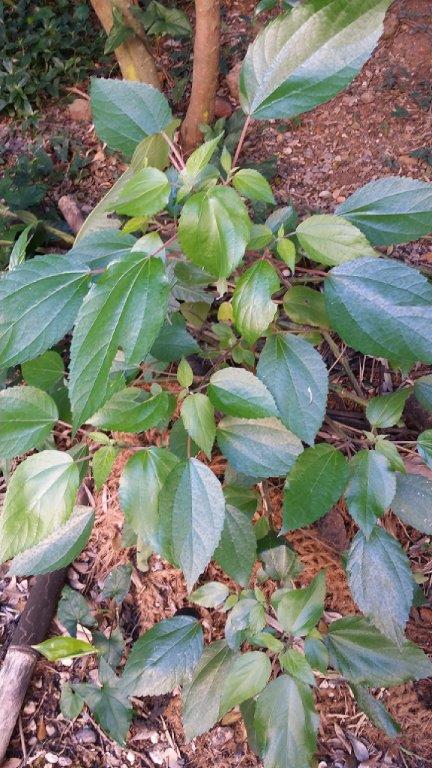I have written here before about my miserable efforts to grow vegetables. Nothing has changed. I am however growing more and more food in my garden. My family eat numerous subtropical edibles and lots of weeds. Not so many carrots and zucchini but plenty of highly nutritious greens.

Ripe berries of the blackberry nightshade (Solanum nigrum) make a great gardening snack
After reading Vic Chericoff’s recently released book ‘Wild Foods’ I now hope to also include local native edibles into my garden – a garden which is certainly much more of a cottage garden than a food garden.
Why not just grow some basic vegetables I hear you ask? Well apart from the fact that I am not very good at growing vegetables (certainly not as good as I am at growing weeds), vegetables are in most cases massively genetically altered plants. They may not have been genetically engineered in a laboratory, but they have certainly been selectively bred for centuries or even more to produce larger, sweeter results. This makes them sweeter (for us and the pests!) and showier but not necessarily tastier. Even those tasty heritage varieties are not as nutritionally dense as the original wild foods that are the ancestors of our modern vegetables – although they are often closer to the original wild food plants than are some modern varieties.

Blackberry nightshade plant (Solanum nigrum) – note that the berries are only safe to eat when they are ripe (black) and sweet
A good example is lettuce. Lettuce is a hugely popular modern vegetable which is often described as crunchy water. It does have some nutritional value but not a lot. There are alternatives to the mainstay of a salad than lettuce. The subtropical vegetables aibika, sweet leaf and sambung all make great lettuce alternatives as does the weed chickweed. They are also all nutritional powerhouses, and feature in my cooking because they require almost no attention from me at all to grow abundantly.
The common weed prickly lettuce is actually the wild plant that modern lettuce was bred from over many centuries. It is too bitter to be used in a salad, rather is best used in the same way as Asian lettuce and cooked lightly. It has a much higher nutritional value than does its modern counterpart and is freely available to us as a common weed.
What are wild foods? In my experience so far these are largely edible weeds, of which there are many. I have written here before about edible weeds and I teach edible weeds workshops, so my passion for this wonderful source of free food is not news.

Fresh young cobblers pegs (Bidens pilosa), the leaves make a great pot herb (spinach substitute)
Wild foods are often found by foraging – seeking them out in natural places rather than by growing them on a farm or in neat rows. Weeds and local native plants can be wonderful wild foods regardless of where in the world you are. Local or climatically unique edible plants (basically anything which exists outside the limited spectrum of commercially available food plants and which suits your local growing conditions) are not strictly wild foods but I mention them here as they offer us with the opportunity to grow food outside the constraints of the vegetable garden and without high inputs.
Subtropical edibles are important to me as I live in a subtropical climate. Often they are still reasonably traditional foods as used by many subtropical cultures, and have had much less selective breeding, making them closer to wild foods than what we find at the green grocer in most cases. Arno King has written some great articles here on GardenDrum about subtropical edibles.

Green amaranth (Amaranthus viridis), a common weed but also a delicious and nutritious food
I am now looking further at local native bush foods to add to my garden and provide me with healthy wild snacks. Bush foods, meaning local endemic plants which are edible, are wild as they are growing in their natural environment.
Chericoff’s book is largely aimed at chefs and why they should use Australian native foods, with a call to action to farmers and investors to commercialise and make available more of Australia’s native food plants. I am not a chef (nor much of a cook at all to be honest), a farmer nor an investor so found much of the information in this book not directed at me. I did feel inspired however and probably finished the book not just a little wiser but much more curious. While Chericoff talks about a handful of significant native Australian plants with commercial food potential, he also talks about the nutritional value of native foods, and of the Aboriginal diet, information which is also the subject of another new book on the topic, John Newton’s ‘The Oldest Foods on Earth‘.
The key point being that plants grown in their ‘right’ environment, that can thrive without the need for significant human intervention by way of fertiliser, water and pest control, have a tendency to have significantly higher nutritional value. Even plants grown in terrible soil can be tasty and highly nutritious, if they are adapted to growing well in that soil and climate.

When nasturtiums (Tropaeolum majus) and dock (Rumex sp) come up in the garden, they get harvested for dinner
This information provides an exciting opportunity for home gardeners everywhere to massively improve the nutritional value of their home grown produce – without having to work any harder in the vegetable patch! This is true no matter where in the world you are, or what climate you may be living in.
Of course it is worth mentioning at this point that not all wild foods are meant to be staple foods. The recently popular lemon myrtle is a case in point, highly flavourful but it is no spinach substitute. Having said that we are not likely to sit down to a bowl of boiled rosemary either, so I think we can appreciate that some plants are important as flavouring only. This is due in part to the high essential oil content, something Australian plants are well known for, and may be part of the explanation for why the aboriginal people ate very few leaf vegetables.
Australia is a very big place, so simply embracing Australian native foods may not be enough for us as home gardeners. The main reason being that with such a huge and climatically diverse country, just because the plant is native to Australia, does not mean it is being grown in its right environment. By narrowing the selection down to a more local area, information may be more difficult to find, but the plants are likely to grow well without the need for intervention by us.
While Australians have embraced our native plants in a country wide scale, celebrating the localised indigenous flora has been slower to catch on. Sadly so much of the Indigenous people’s knowledge of local wild foods has been lost, leaving us with a landscape full of food that we know sadly too little about.

Native mulberry tree (Pipturus argenteus) recently planted into a garden
Local native plants groups are doing a wonderful job of making us more aware of local native plants and are making more of these plants available to us as gardeners. They are largely coming from a (very important) biodiversity and conservation point of view. I purchased a small bolwarra (Eupomatia bennettii ) from one such group purely for its ornamental value. It wasn’t until I had the chance to participate in a bushfoods tour a year later that I found out that this plant produces an edible fruit similar to a guava. Since this tour I have also added to my garden native ginger (Alpinia caerulea), native elderberry (Sambucus australasica), pink lime berry (Glycosmis trifoliata) and a native raspberry (Rubus probus). These plants are all endemic to South East Queensland where I live, so should do ok in my garden without too much help from me. They are all also quite able to be tucked in amongst the existing garden without the need to adapt my style of garden.
There are enormous benefits to me as a gardener to seek out and grow some of these plants. The curiosity and the biodiversity aspects of these plants are something all gardeners will relate to, but for me, they are even more than that – they are food. Not perhaps a regular or reliable supply but they add something of value to my diet.
All of these plants – weeds, subtropical edibles and local natives, work so well in my style of food gardening – that being a forage through a somewhat wild but gloriously beautiful cottage garden laden with flowers, to find a good feed! Even better, they are able to contribute to the aesthetics of the garden without me needing to fuss over them – that is a huge win-win in my world of gardening!! You may be surprised how easily some weeds can blend in and look great.
Of course the question has to be asked – if we are growing these wild foods in our gardens, are they still wild? The important answer to this is that they are not so far from wild, and when we garden sustainably without over reliance on fertilisers and pest control, our gardens are thriving healthy ecosystems able to easily reward us with tasty and nutritionally dense food.
